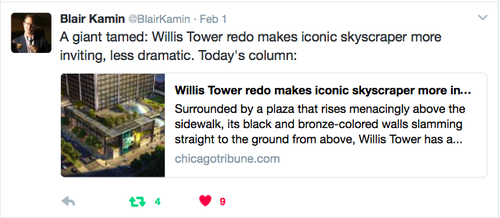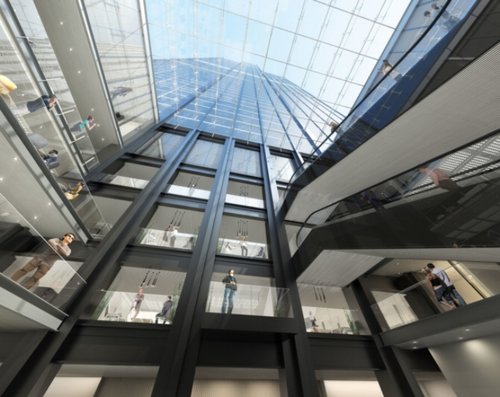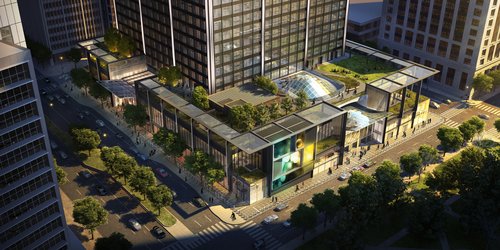When one hears the word “renovation,” conjures “fixer-upper,” or even reads the simple phrase “lobby redo,” the mind does not naturally envision a price tag of half a billion dollars.
But then again, your condo association is probably not debating proposed improvements for the second-tallest tower in North America, which is also one of the great structural engineering achievements in human history. Last week, however, that was exactly the subject matter when Willis Tower owner Blackstone Group and the City of Chicago unveiled plans for a $500 million extreme makeover—just for the bottom floors—of the iconic, 110-story skyscraper formerly known as Sears Tower.
When that 1,729-foot-tall black building—designed and engineered by Chicago-based SOM and built by Morse Diesel International (now AMEC Foster Wheeler)—opened in 1974, its construction cost was estimated at $150 million. In 2017, that translates to $810 million. So, any way you crunch the numbers, the new project is a big deal. Under a design-build contract, the new work will be performed by an all-star team of architect Gensler and joint-venture builders Turner and Clayco. Blackstone estimates that it will create some 2,500 jobs.
“The investment we announced today is the largest Blackstone has ever made in reimagining one of its properties.”
“[This] investment is the largest Blackstone has ever made in reimagining one of its properties,” said Jon Gray, Blackstone’s global head of real estate. “Our goal is to restore Willis Tower to its original prominence and make it a must-visit destination in Chicago.”
“With this historic investment, Willis Tower will remain a vibrant and modern icon that inspires both young and old for generations to come,” Mayor Rahm Emanuel added. “But more than that, today, Blackstone is doubling-down on its confidence in the future we are building in the city of Chicago.”
Claiming momentum, the mayor also pointed to recent announcements from fast-food giant McDonald’s Corp. and, just last week, equipment manufacturer Caterpillar Inc. that both corporate titans will move their global headquarters to downtown Chicago.
Specifically, the reimagining of Willis Tower’s base is now in the hands of design giant Gensler, which released several renderings at last week’s press event. The goal is to make the tower—long derided as a giant monolith reminiscent of the one in the 1968 sci-fi classic 2001: A Space Odyssey—more in tune with its surroundings and more engaging to the driverless Millennials who are increasingly filling downtowns.
- According to Blackstone: Willis Tower was built atop a base to separate the urban streetscape from the building and minimize the number of people walking along the sidewalk. The new plans break this barrier, blending the building into the city … and reenergizing the downtown area.
Pulitzer-prize-winning critic Blair Kamin gave the plans mostly positive reviews last week. For more, click here.
As part of the transformation, Equity Office, an office portfolio company owned by Blackstone’s real estate funds, will reconfigure some 460,000 square feet of space within the 4.5 million-square-foot tower. Gensler has redesigned 150,000 square feet for tenant-only use and also added more than 300,000 square feet of new retail, dining, and entertainment space, plus a new 30,000-square-foot outdoor deck and garden.
“We are pleased to be in the position to draw on [late SOM architect] Bruce Graham‘s original inspiration for this tower and to have the opportunity to harmonize his enduring vision with the changes that have since occurred in the city and its neighborhoods and in the nature of the way we use urban environments for work, life, and play,” said Eli Khouri, CEO of Equity Office. Of note: in the late 1960s, Graham had teamed with legendary SOM structural engineer Fazlur Khan to realize the tower’s original vision. (Together, they devised the famed “bundled tube” design that enabled its record height.)
For its part, the 2017 transformation will include a new three-story transparent glass structure set atop the existing stone plaza. This will attract visitors into a ‘see-and-be-seen’ experience that invites them to engage, linger, and enjoy the streetscape, Blackstone says. Below the glass facade will be retail floors, organized around a three-story winter garden crowned with a skylight that provides unobstructed views of all 110 floors above. Construction is expected to begin this month.






Discussion
Be the first to leave a comment.
You must be a member of the BuiltWorlds community to join the discussion.